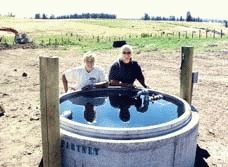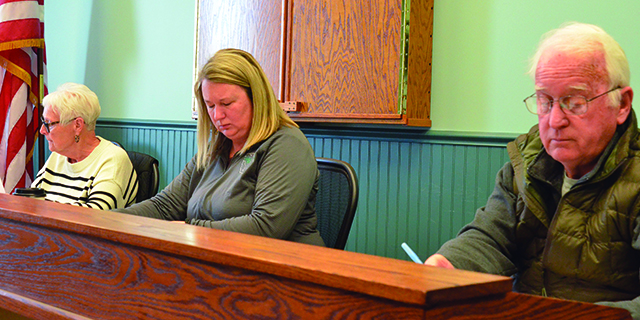LOCAL RANCHES WIN STATE STREAM AWARD
Published 12:00 am Wednesday, April 27, 2005

- Restoration recognized: Ranch owners Kelly Stinnett, left, and Shauna Mosgrove view one of nine watering troughs installed to provide water for horses and cattle that were excluded from streams by restoration project fences. (Submitted photo).
The State Land Board has presented the 2004 Stream Project Award to owners of Alta Cunha and Moss Creek ranches west of La Grande for restoration of the Longley Meadows.
Ranch owners Carla Cunha, Shauna Mosgrove and Kelly Stinnett along with numerous partners began planning the project in 1999. From 2002 to 2004 they restored habitat in the stream, on streambanks and in wetlands along seven miles of three creeks and the main stem of the Grande Ronde River.
Seven miles of fence were built to keep livestock away from the creeks and river, 40,000 shrubs and trees were planted, and nine off-channel water sources were developed for livestock.
The project improved habitat along a one-mile segment of the Grande Ronde River. Partners restored one mile of the Bear Creek channel to its historic configurations through Longley Meadow. The new, meandering channel doubled instream habitat and slowed water flow over gravelly streambeds. Crews also placed whole trees in one mile of Jordan Creek.
To preserve the investment in the project, the ranch owners enrolled 445 acres of land adjacent to the creeks and river in the Conservation Reserve Enhancement Program and the Bonneville Power Administration’s Fish Habitat Program. The agreements establish a 15-year streambank conservation easement.
Fourth-generation ranch owner Mosgrove said that she, her mother Carla, and ranch co-owner Kelly started the project "with the traditional cattle operation perspective help the stream, but keep the meadow for grazing." Project planners soon realized this wasn’t possible. They toured similar projects.
"I had grown up seeing streambank areas looking like putting greens and thought that was normal," she said. "I soon learned that restoration can bring huge benefits to a stream."
Through numerous "stream summits" at the ranch with eight or nine project partners, the group found solutions that allowed stream restoration as well as grazing. Staff from the Natural Resources Conservation Service helped develop water sources other than the creeks, and assisted with pasture rotation plans to offset the grazing lost when the meadow was fenced off.
"A major surprise came when we found out that existing springs wouldn’t be an adequate water source for the livestock," Mosgrove said.
The solution? Two wells, one of which is powered by a solar pump "that is working wonderfully," she added.
Five years after the start of planning, Mosgrove said it is satisfying to know that "you can do good things for the resource while keeping a viable cattle operation."
Mosgrove said the highlight of the project occurred last spring when a Oregon Department of Fish and Wildlife biologist came to tell her that steelhead were building spawning nests in the restored creek bed.
Project partners included several local, state and federal agencies.
The cost of the project was $265,000 of which BPA’s Fish Habitat Program contributed $145,000 for fencing and construction of the new channel. Other financial contributors included the Natural Resources Conservation Service, the ODFW, the Oregon Department of Transportation, the Grande Ronde Model Watershed Program and the Confederated Tribes of the Umatilla Indian Reservation, which managed the project.
The Oregon Department of Transportation selected the Longley Meadow Project to offset loss of wetlands at the nearby Lower Perry Bridge. ODOT provided $12,000 to develop a small wetland and $5,400 for planting trees and shrubs along the Grande Ronde.
The State Land Board Awards were established in 2003 to promote and recognize responsible, sustainable stewardship of natural resources.





